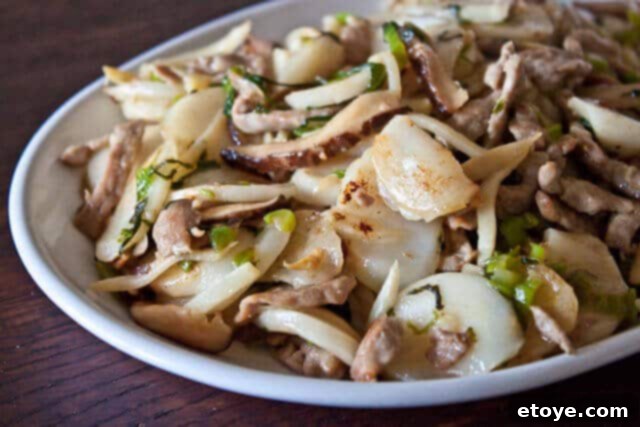
There’s something truly special about the meals shared with family, especially when they feature dishes passed down through generations. Recently, during a wonderful surprise visit to my family, my Mom, a phenomenal cook, prepared a couple of dishes that I rarely make myself. Among them was this incredibly comforting and flavorful Chinese Fried Sticky Rice Cake Noodle dish, known in Chinese as 炒年糕 (Chǎo Nián Gāo). This particular recipe hails from my Dad’s ancestral hometown of Ningbo, China, offering an authentic taste of traditional family cooking.
Sharing this recipe feels like sharing a piece of my heritage. It’s a dish that not only warms the stomach but also brings back cherished memories of home, family gatherings, and the distinctive aromas of my mother’s kitchen. Its unique chewy texture and savory flavor profile make it a standout, and I’m thrilled to guide you through the process of creating this delightful meal in your own home.
Understanding Sticky Rice Cakes: The Heart of Nian Gao (年糕)
Nian Gao, or sticky rice cakes, hold a significant place in Chinese culinary traditions, particularly during the Lunar New Year celebration. The name itself is steeped in auspicious meaning: “Nian” (年) translates to year, and “Gao” (糕) sounds similar to “Gao” (高), meaning high or tall. This phonetic play translates into the popular idiom “年年高升” (nián nián gāo shēng), which expresses a wish for increasing prosperity and success year after year. It’s this symbolic significance that makes Nian Gao a cherished dish, believed to bring good fortune and progress in the coming year.
Beyond its festive role, Nian Gao encompasses a variety of glutinous rice cake preparations. While some versions are fried with egg for a savory bite or with sugar for a sweet treat, this specific recipe focuses on a popular savory style, often enjoyed as a hearty meal. This preparation involves taking glutinous rice cakes, typically sliced into oval shapes measuring approximately two inches long and one inch wide, and stir-frying them with an array of ingredients much like noodles. You might find similar versions in other East Asian cuisines, such as the Shanghainese style or the Korean TteokGuk, which also feature these delightful chewy rice cakes as a base for their savory preparations.
Finding the right rice cakes is crucial for this dish. You can generally locate them in the Asian markets, often in a few forms: dried (usually in the dried noodle section), frozen, or fresh in the refrigerated noodle section. My Mom, ever practical, prefers to buy the frozen variety as they store wonderfully in the freezer, making them readily available for spontaneous cooking. Regardless of whether you choose the Korean or Chinese version, rest assured they are quite similar in texture and composition, making either suitable for this recipe. The most important step for any form (except perhaps very fresh ones that don’t need it) is proper soaking. This process rehydrates them, ensuring they cook through evenly and achieve that perfect chewy-yet-tender consistency.
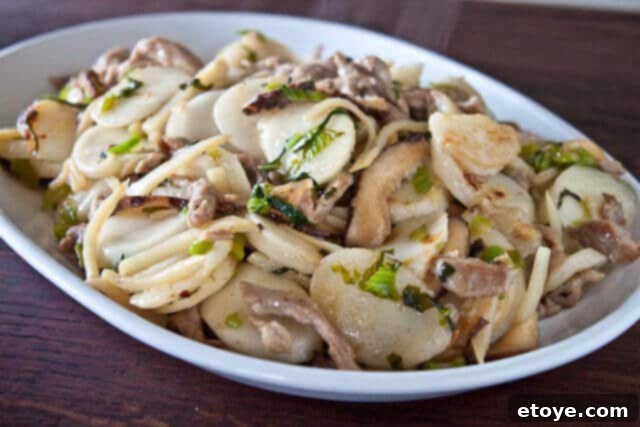
The rice cakes require proper soaking for at least 2 hours, or even overnight, depending on their initial state.
Essential Ingredients for a Flavorful Stir-Fry
The beauty of Chǎo Nián Gāo lies in its harmonious blend of simple yet deeply flavorful ingredients. Each component plays a vital role in building the dish’s rich taste and satisfying texture. Let’s delve into the key elements:
Dried Chinese Mushrooms (or Shiitake)
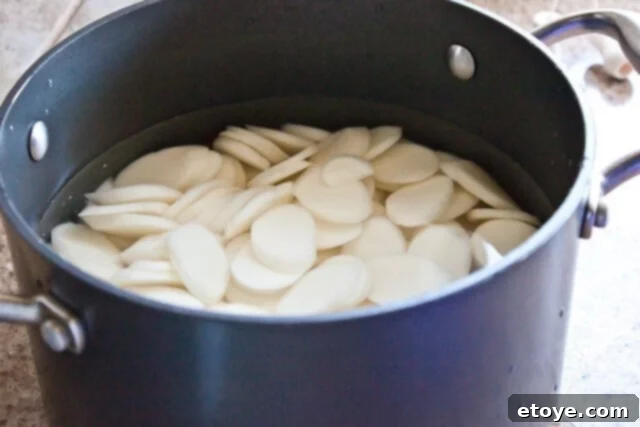
For an authentic umami depth, dried Chinese black mushrooms are unparalleled. They boast a concentrated flavor that fresh shiitake mushrooms, while a perfectly acceptable substitute, simply can’t replicate. If you opt for dried mushrooms, remember to plan ahead, as they need to be rehydrated for a few hours or even overnight. This process not only softens them but also infuses the soaking liquid with an intense flavor that can be incorporated into the broth for an extra layer of taste. For convenience, fresh shiitake mushrooms work wonderfully and require no pre-soaking.
Canned Bamboo Shoots
These add a delightful crunch and slightly sweet, earthy note to the stir-fry. Canned julienned bamboo shoots are widely available and convenient, requiring just a quick drain before use. Their crisp texture provides a pleasant contrast to the soft chewiness of the rice cakes.
Napa Cabbage (or Salted Mustard Greens)
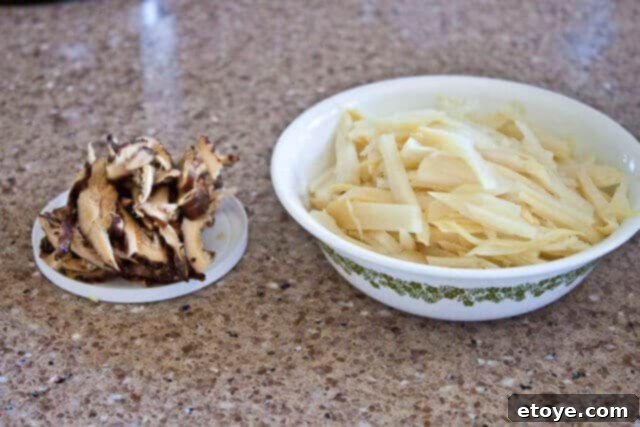
My Mom often uses salted mustard greens, a traditional ingredient that imparts a unique tangy, savory flavor. However, for a more accessible and equally delicious option, Napa cabbage is an excellent choice. Its mild sweetness and tender texture complement the other ingredients beautifully without overpowering them. When stir-fried, it wilts down to a soft, flavorful addition, providing essential freshness and a slight sweetness to the dish.
Marinated Pork

The pork is a star in this savory dish, and proper marination is key to achieving tender, flavorful strips. We use very thinly sliced pork, which cooks quickly and absorbs the marinade effectively. The marinade typically consists of soy sauce for saltiness and umami, Chinese rice wine (or dry sherry) for depth and aroma, a pinch of sugar to balance flavors, freshly ground black pepper for a subtle kick, and cornstarch. The cornstarch is vital, as it creates a thin protective coating around the pork, preventing it from drying out during stir-frying and ensuring a silky, tender texture. Marinating for at least 20 minutes, or even overnight in the refrigerator, allows the flavors to fully penetrate the meat.
The Art of Stir-Frying: Step-by-Step Perfection
Stir-frying is a quick cooking method that, when done correctly, locks in flavors and textures. For this Chǎo Nián Gāo, timing and high heat are your best friends.
Step 1: Preparing Your Ingredients
Before you even touch the wok, ensure all your ingredients are prepped and ready to go. This “mise en place” is crucial for stir-frying, as the cooking process is very fast. Drain your soaked rice cakes thoroughly. If using dried mushrooms, drain and slice them thinly. Slice your pork, shred your cabbage, and have your bamboo shoots drained. This preparation ensures a smooth and efficient cooking experience.
Step 2: Searing the Pork

Begin by heating your wok or a large sauté pan over high heat until it’s very hot, almost smoking. Swirl in the cooking oil, allowing it to coat the surface. Add the marinated pork strips and stir-fry them quickly. The goal here is to brown the pork and cook it until it’s almost done, but not fully cooked through, as it will continue to cook with the other ingredients. This initial searing helps to develop a rich flavor and ensures the pork remains tender.
Step 3: Adding the Mushrooms and Bamboo Shoots

Once the pork is nearly cooked, add the sliced Chinese mushrooms to the wok. The mushrooms will absorb the flavors from the pork and oil, contributing their earthy notes. Continue to stir-fry for about a minute.
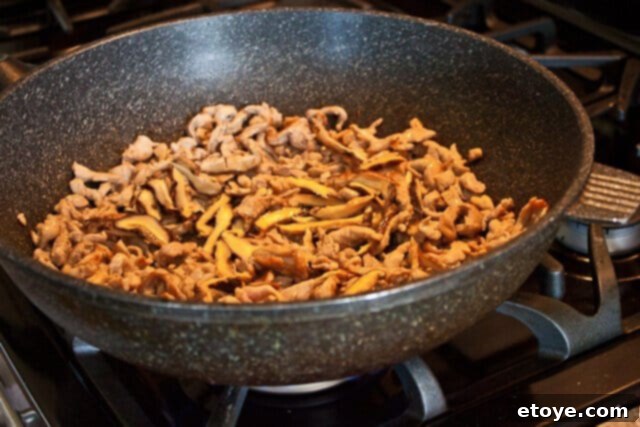
Next, introduce the drained bamboo shoots. Stir-fry for another minute, allowing them to heat through and meld with the other ingredients while retaining their delightful crunch.
Step 4: Incorporating the Vegetables
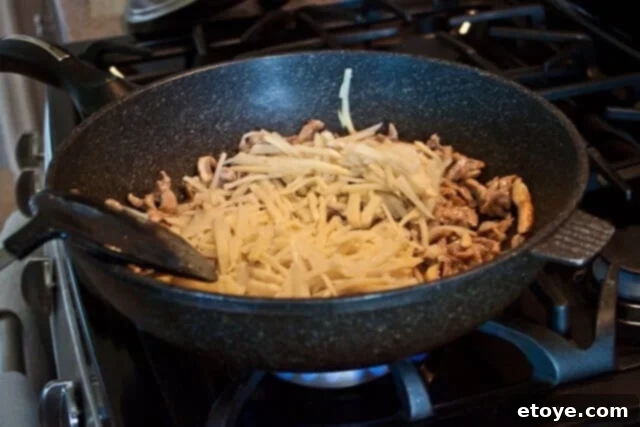
Add the shredded Napa cabbage to the wok. Stir-fry for approximately two minutes, just until the cabbage begins to wilt but still retains some crispness. Overcooking the cabbage will make it soggy, so a quick stir-fry is key. After the cabbage has softened slightly, mix in a tablespoon or two of soy sauce, tossing everything well to ensure an even distribution of flavor.

Toss all the ingredients together vigorously, ensuring every piece is coated in the savory sauce. This step allows the flavors to truly marry.
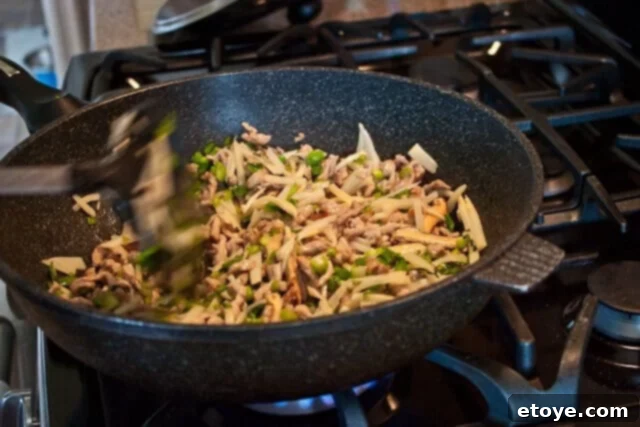
Season with a bit more soy sauce, if needed, always tasting as you go to achieve the perfect balance. Remember, you can always add more, but you can’t take it away.
Step 5: Adding the Rice Cakes and Finishing
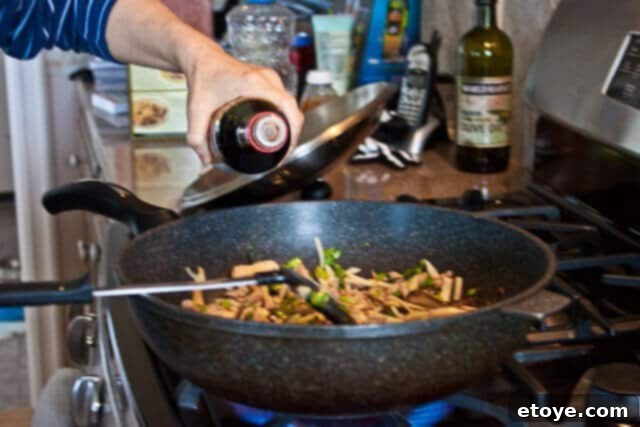
Finally, add the drained rice cakes to the wok. This is where the magic truly happens. Toss, toss, toss!
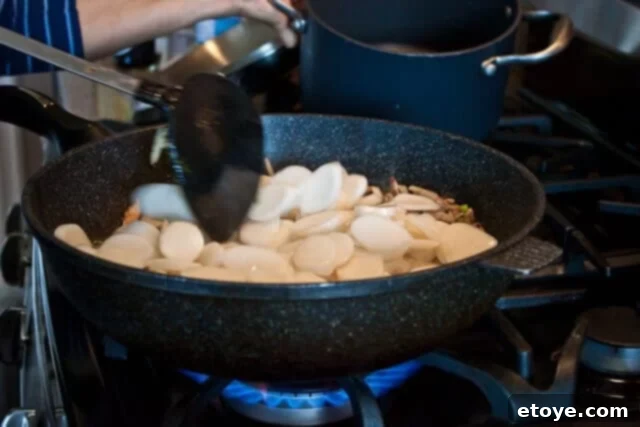
Ensure the rice cakes are thoroughly mixed with all the other ingredients and coated in the delicious sauce. The goal is for them to absorb the flavors and soften further.
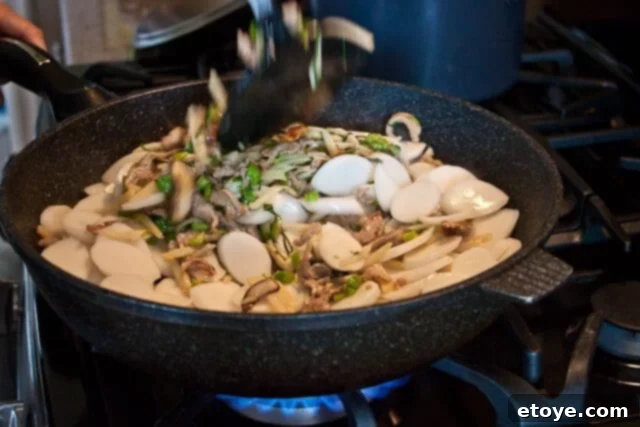
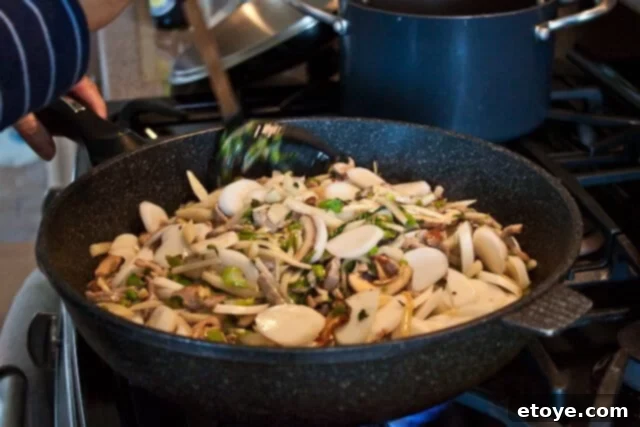
Pour in about 1/4 cup of chicken or vegetable broth. This liquid is essential for softening the rice cakes and creating a luscious, savory sauce. Cover the wok and reduce the heat to low. Allow it to cook for 2-3 minutes. During this time, the rice cakes will steam and soften, becoming wonderfully chewy and tender. They should have a texture similar to pasta cooked al dente—soft enough to bite through, but with a satisfying chew, not mushy.
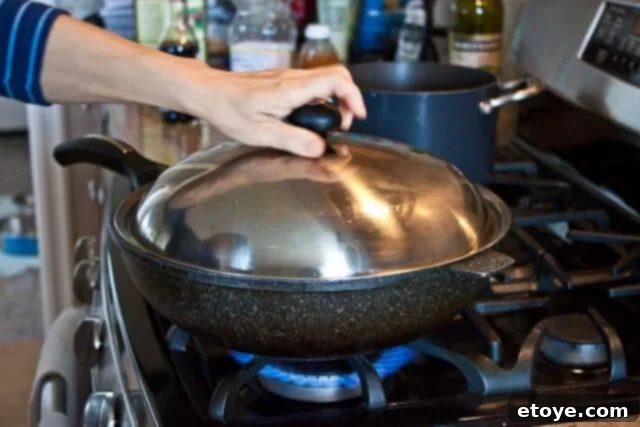
Once the rice cakes are softened to your liking, remove the lid. Give it one final toss. Taste and adjust seasoning with additional soy sauce if necessary. Serve immediately to enjoy the best texture and flavor.

Stir Fried Chinese Sticky Rice Cakes (Nian Gao) Recipe (炒年糕 chǎo nián gāo)
This traditional Ningbo-style Chǎo Nián Gāo recipe brings together tender pork, fragrant mushrooms, crisp bamboo shoots, and soft, chewy sticky rice cakes in a savory stir-fry. It’s a comforting and auspicious dish perfect for any occasion.
Notes on the Sticky Rice Cakes:
- The rice cakes are typically gluten-free, but always check the packaging to confirm.
- If dried: Soak in water at room temperature overnight, or up to 2 days, until fully softened.
- If frozen: Defrost them first, then soak in water at room temperature for 2 hours up to overnight.
- If fresh (from the refrigerated section): Soak for 2 hours in water at room temperature up to overnight to ensure optimal texture.
Notes on Mushrooms:
- For a deeper, more robust umami flavor, my Mom prefers dried Chinese black mushrooms over fresh shiitake. Dried mushrooms require rehydration, which also yields a flavorful soaking liquid that can enhance your broth. Feel free to use either, depending on preference and availability.
Prep Time: From 15 minutes to overnight soaking of rice cakes and mushrooms.
Rating: 5 out of 5 stars from 3 votes.
Print Recipe
Cook Time: 15 minutes
Servings: 6
Ingredients
- 1 (24-ounce) package rice cake nian gao noodles (see notes above for preparation)
- 4 dried Chinese black mushrooms (or 8 fresh shiitake mushrooms)
- 2 teaspoons soy sauce (for pork marinade)
- Freshly ground black pepper (for pork marinade)
- Pinch of sugar (for pork marinade)
- 1 teaspoon Chinese rice wine (or dry sherry, for pork marinade)
- 1 teaspoon cornstarch (for pork marinade)
- 8 ounces pork, cut into very thin strips
- 2 tablespoons cooking oil
- 6 ounces Chinese Napa Cabbage, shredded
- 1 (6-ounce) can julienne cut bamboo shoots, drained
- 2 tablespoons soy sauce (for stir-fry seasoning)
- 1/4 cup chicken or vegetable broth
Instructions
- In a large bowl, soak the rice cakes according to the instructions in the headnotes (dried, frozen, or fresh). If you are using dried Chinese black mushrooms, in a separate small bowl, soak them for 2 hours or up to overnight until softened. If using fresh shiitake mushrooms, you can skip this soaking step.
- In a medium bowl, combine the 2 teaspoons of soy sauce, black pepper, sugar, Chinese rice wine, and cornstarch. Mix well. Add the thinly sliced pork strips to this marinade, ensuring they are evenly coated. Marinate for at least 20 minutes, or for best results, cover and refrigerate overnight.
- When you are ready to cook, ensure all your ingredients are prepared and within easy reach. Drain the soaked rice cakes completely. If using dried mushrooms, drain them and slice them into very thin pieces.
- Heat a wok or a large sauté pan over high heat until it’s very hot. Swirl in the cooking oil to coat the bottom and sides. Add the marinated pork and stir-fry until it is browned and almost cooked through, but still slightly pink in the center.
- Add the sliced mushrooms and the drained bamboo shoots to the wok. Stir-fry for 1 minute, allowing their flavors to meld with the pork. Next, add the shredded Napa cabbage and continue to stir-fry for 2 minutes, until the cabbage begins to wilt. Mix in the 2 tablespoons of soy sauce, tossing everything well.
- Add the drained rice cakes to the wok. Toss everything vigorously to ensure the rice cakes are thoroughly coated with the sauce and mixed with the other ingredients. Pour in the chicken or vegetable broth, cover the wok, and reduce the heat to medium-low. Cook for 2-3 minutes, or until the rice cakes have softened and developed a slightly chewy, “al dente” texture. Taste and add additional soy sauce if needed to adjust the seasoning. Serve immediately while hot.
I genuinely hope you try making this authentic Chinese Stir Fried Sticky Rice Cakes (Nian Gao) recipe. It’s a dish that carries deep cultural meaning and delivers immense comfort with every savory, chewy bite. Recreating a family recipe like this is a wonderful way to connect with tradition and create new memories around your own dining table. Don’t hesitate to experiment with the vegetables or protein to make it uniquely yours, but always savor the core elements that make Nian Gao so special. Share your experiences and any variations you discover – I’d love to hear how it turns out for you!
